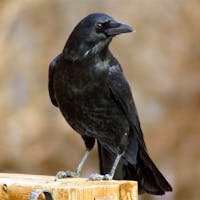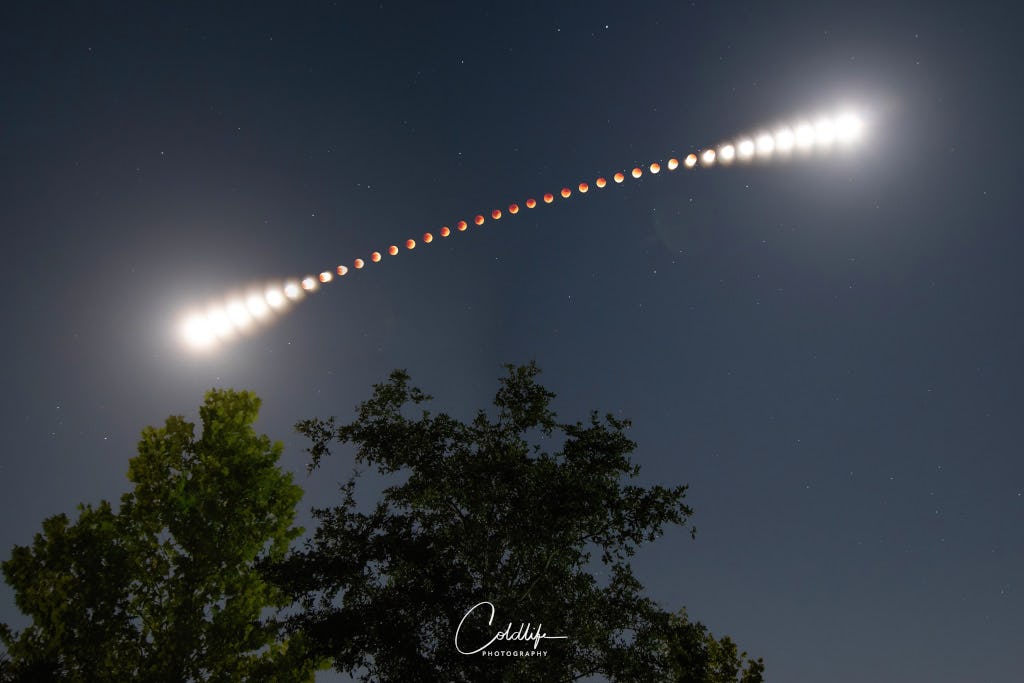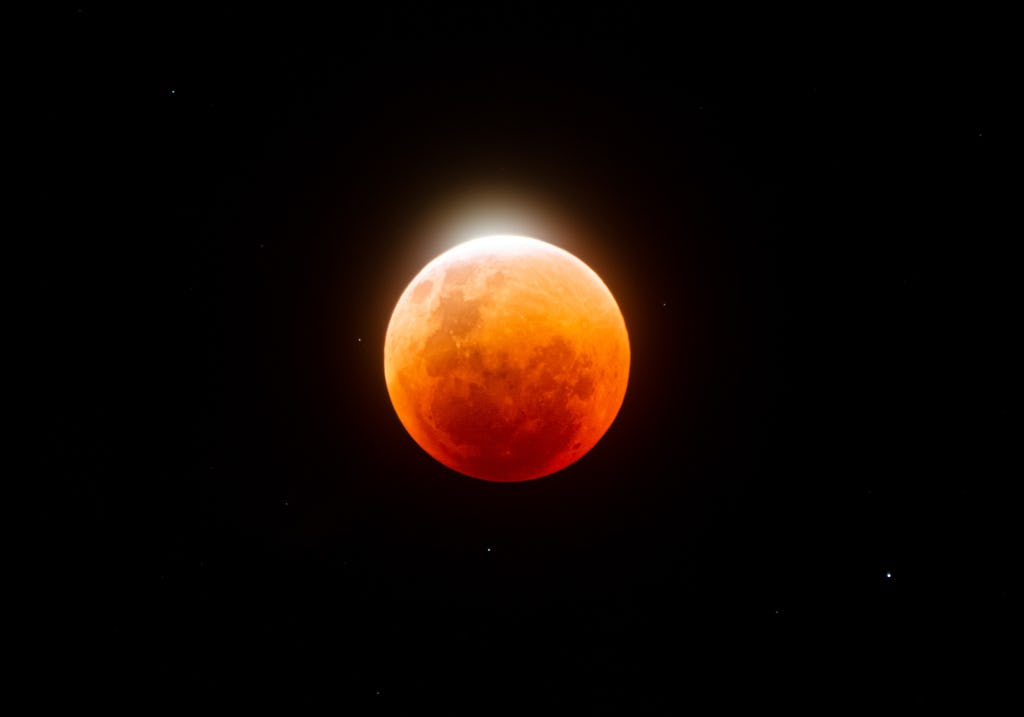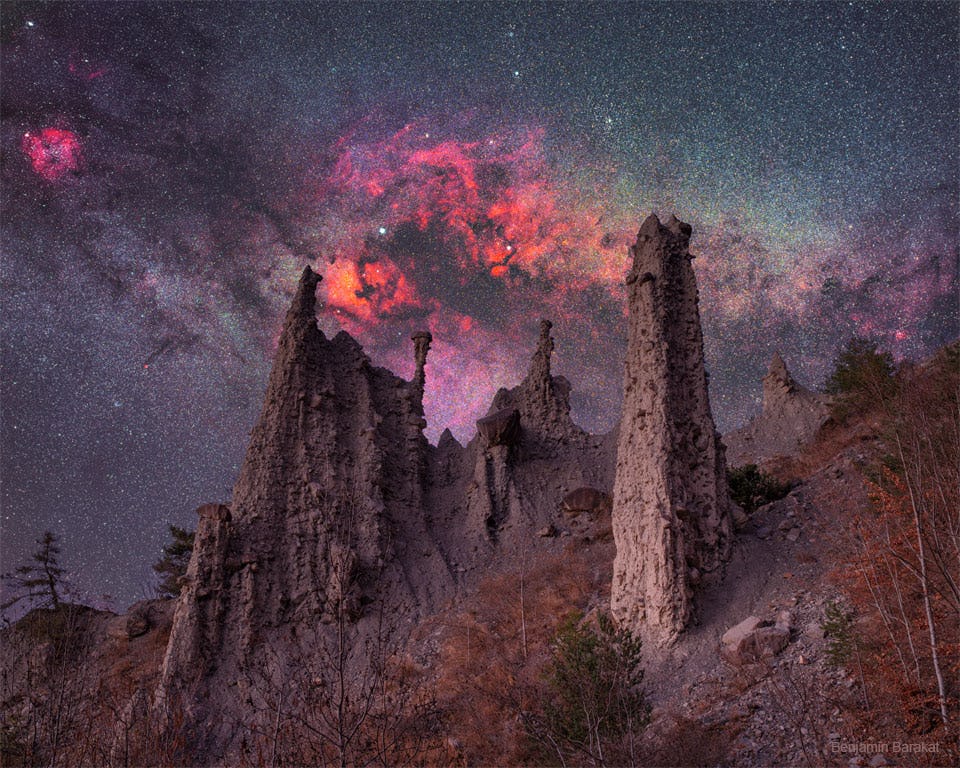"Government-created monopolies, Import restrictions and ‘Lean’ supply chains have contributed to the problem". Read the full article
Public Posts Stanwood, WA Stanwood, WA (zoom)
NASA Astronomy Picture of the Day:
Recorded on May 15/16 this sequence of exposures follows the Full Moon during a total lunar eclipse as it arcs above treetops in the clearing skies of central Florida. A frame taken every 5 minutes by a digital camera shows the progression of the eclipse over three hours. The bright lunar disk grows dark and red as it glides through planet Earth's shadow. In fact, counting the central frames in the sequence measures the roughly 90 minute duration of the total phase of this eclipse. Around 270 BC, the Greek astronomer Aristarchus also measured the duration of total lunar eclipses, but probably without the benefit of digital watches and cameras. Still, using geometry he devised a simple and impressively accurate way to calculate the Moon's distance in terms of the radius of planet Earth, from the eclipse duration.
Photo by Michael Cain
"Each morning, the people incarcerated in India’s open prisons head out to work, to visit family, or to simply wander the city. And at the end of the day, in virtually every case, they come back. The premise is simple: when a system trusts and respects its prisoners, the prisoners trust and respect the system. Could this work anywhere?" Continue reading

Fresh Dungeness crabmeat, parsley, bread crumbs, egg, lemon juice, Tabasco, Worcestershire sauce, Dijon, paprika, thyme, onion, and bell pepper. Serve with horseradish mayo. See Recipe
NASA Astronomy Picture of the Day:
Cloudy skies plagued some sky watchers on Sunday as May's Full Flower Moon slipped through Earth's shadow in a total lunar eclipse. In skies above Chile's Atacama desert this telephoto snapshot still captured an awesome spectacle though. Seen through thin high cirrus clouds just before totality began, a last sliver of sunlit crescent glistens like a hazy jewel atop the mostly shadowed lunar disk. This full moon was near perigee, the closest point in its elliptical orbit. It passed near the center of Earth's dark umbral shadow during the 90 minute long total eclipse phase. Faintly suffused with sunlight scattered by the atmosphere, the umbral shadow itself gave the eclipsed moon a reddened appearance and the very dramatic popular moniker of a Blood Moon.
Photo by Tomas Slovinsky
When you start a new business, it’s important to branch out and integrate with your local community. Your friends and neighbors are not only potential customers but also collaborators and brand ambassadors. Here are some tips for forming a successful new business and connections.
Establishment
Before you head out and begin to shake hands, it’s important to get the fundamentals of your business right. If you’ve recently moved to the area, it’s important to ensure that all of your paperwork is in order - this means setting up your business structure, bank account, registering for taxes, securing web domains, applying for licenses & permits, calculating financial projections and, of course,
writing a solid business plan. Some of these are regional-specific (for example, business structure) meaning you’ll need to observe state regulations during proceedings.
A business plan is crucial for attracting investment in your business and for its long-term ambitions. You can use this document to structure, run and grow your business - detailing the company, its mission, competitors, structure, products, and financial requirements. There are plenty of resources online to help you nail down this important step.
Networking
Once you’re legal, the next step is to get the word out. It might fall outside of your comfort zone but going out and networking in person is still an important part of establishing yourself in the local community. A simple introduction goes a long way but it helps to go a step further. By giving a hand at community events, for example, you can contribute to a cause whilst developing a report with
potential business prospects. Or, by sharing your services, you’ll be getting the word out about your business and lending help to those who need it.
Almost as important as your physical presence is your digital one. Take the time to reach out and connect with those in your local community via social media on Instagram, Facebook, and Linkedin. You may find it helps to join some of the local groups and just engage in conversations/introduce yourself (although it helps not to make discussions so business-centric).
Marketing
Even with the word out, promoting your business takes precedence if you want to establish yourself in the minds of your local community. Marketing can help with this and encompasses everything from designing a standout logo to paying for advertisement. Often, it’s a good idea to start small with placements in local newspapers, free samples in other shops, sponsoring local events, or even hiring out nearby billboards. The key here is to get yourself as thoroughly involved as possible.
If you have the budget, you may also decide it makes sense to pay for online pay-per-click (PPC) campaigns or with Google placements. Digital marketing is one of the most cost-efficient ways to promote your business and it can help you to expand your reach across the whole community and beyond. Especially in sparsely populated areas of the country, it can be difficult to get eyes on your product but with smartphones and social media, you can tactically place your brand in a digital space where it’s bound to be seen.
In business, having the locals on your side is an advantage that is difficult to measure. If anything goes wrong or if you need a helping hand, you can be sure that your neighbors have your back. Just make sure that whatever goodwill you receive is reciprocated.
Author: Linda Chase of AbleHire.org. Able Hire's Mission is "Helping people with disabilities build rewarding, successful careers."
Kudos 365 is the place to post about your local Community events and activities or to share your photography, art, or other expertise.
Image by Pexels
NASA Astronomy Picture of the Day:
Astronomers turn detectives when trying to figure out the cause of startling sights like NGC 1316. Investigations indicate that NGC 1316 is an enormous elliptical galaxy that started, about 100 million years ago, to devour a smaller spiral galaxy neighbor, NGC 1317, just on the upper right. Supporting evidence includes the dark dust lanes characteristic of a spiral galaxy, and faint swirls and shells of stars and gas visible in this wide and deep image. One thing that >remains unexplained is the unusually small globular star clusters, seen as faint dots on the image. Most elliptical galaxies have more and brighter globular clusters than NGC 1316. Yet the observed globulars are too old to have been created by the recent spiral collision. One hypothesis is that these globulars survive from an even earlier galaxy that was subsumed into NGC 1316. Another surprising attribute of NGC 1316, also known as Fornax A, is its giant lobes of gas that glow brightly in radio waves.
Photo by Capture: Greg Turgeon Processing: Kiko Fairbairn
I see your face
and then a smile,
giving me a feeling
of your unique style.
A smile, gracious, I am
just a little smitten
by the lovely Bulgarian.
The life we share,
we are not alone,
for we are partners,
in this great unknown.
The great part of life
which touched us before,
is one of a caring love.
A love, which I now
profess to you.
No matter what this
will bring, I'll fight for
you forever. At least,
I will try to level the score.
A Comment by Loy

Very nice…
A Comment by MFish

Thank you, Loy
NASA Astronomy Picture of the Day:
Real castles aren't this old. And the background galaxy is even older. Looking a bit like an alien castle, the pictured rock spires are called hoodoos and are likely millions of years old. Rare, but found around the world, hoodoos form when dense rocks slow the erosion of softer rock underneath. The pictured hoodoos survive in the French Alps and are named Demoiselles Coiffées -- which translates to English as "Ladies with Hairdos". The background galaxy is part of the central disk of our own Milky Way galaxy and contains stars that are typically billions of years old. The photogenic Cygnus sky region -- rich in dusty dark clouds and red glowing nebulas -- appears just above and behind the hoodoos. The featured image was taken in two stages: the foreground was captured during the evening blue hour, while the background was acquired from the same location later that night.
Photo by Benjamin Barakat
Henry David Thoreau (1817 - 1862). American naturalist, philosopher, poet, and essayist. He is best known for his book "Walden" or "Life in the woods", a reflection upon simple living in natural surroundings, and his essay "Civil Disobedience" (originally published as "Resistance to Civil Government"), an argument for disobedience to an unjust state.
For centuries, historians believed that any physical evidence of the pivotal Battle of the Aegates was long gone. Then came a chance discovery – which led to dozens of shipwrecks. .... Read more
Carthaginian Naval Ram image credit: Sicily's Soprintendenza del Mare - Department for Cultural Heritage and Identity.








.jpg?fit=crop&w=280&h=280&q=93)




.jpg?fit=crop&w=200&h=200&crop=faces)













p0c39sy0.webp?fit=max&w=1200&h=1200&q=48)

 - Copy.jpg?fit=crop&w=280&h=280&q=93)


R.jpg?auto=format&fit=clip&w=600)





















